F6F Hellcat
| F6F Hellcat | |
|---|---|
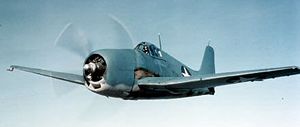 |
|
| A U.S. Navy Grumman F6F-3 Hellcat | |
| Role | Fighter aircraft |
| Manufacturer | Grumman |
| First flight | 26 June 1942 |
| Introduced | 1943 |
| Retired | 1954, USN |
| Primary users | United States Navy United States Marine Corps Royal Navy French Navy |
| Produced | 1942-1945 |
| Number built | 12,275 |
The Grumman F6F Hellcat was a United States Navy carrier based fighter aircraft developed to replace the earlier F4F Wildcat. Although the F6F bore a family resemblance to the Wildcat, it was a completely new design powered by a 2,000 hp Pratt & Whitney R-2800. Some tagged it as the "Wildcat's big brother" [1]. The Hellcat and the Vought F4U Corsair were the primary USN fighters during the second half of World War II.
The Hellcat proved to be the most successful aircraft in naval history, destroying 5,171 aircraft[2] while in service with the U.S. Navy and U.S. Marine Corps (5,163 in the Pacific and eight more during the invasion of Southern France), plus 52 with the Royal Navy's Fleet Air Arm during World War II.[3] Postwar, the Hellcat aircraft was systematically phased out of front line service, but finally retired as late as 1954 as a night-fighter in composite squadrons.
Contents |
Design and development

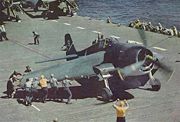
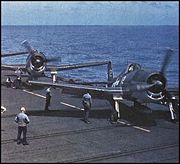
Grumman was working on a successor to the F4F Wildcat well before the Japanese attacked Pearl Harbor. While the F4F was a capable fighter, early air battles revealed the Japanese A6M Zero was more maneuverable and possessed a better rate of climb than the F4F. The F4F did have some advantages over the Zero. Wildcats were able to absorb a tremendous amount of damage compared to the Zero, and had better armament. The F4F was also much faster in a dive than the Zero, an advantage Wildcat pilots used frequently to elude attacking Zeros.
These advantages carried over into the F6F and, combined with other improvements, created a fighter that outclassed the Zero almost completely. The contract for the prototype XF6F-1 was signed on 30 June 1941. The F6F was originally to be given the Wright R-2600 Cyclone engine of 1,700 hp (1,268 kW), but based on combat experience of F4F Wildcat and Zero encounters, Grumman decided to further improve their new fighter to overcome the Mitsubishi Zero's dominance in the Pacific theater. [1]Grumman installed the Pratt & Whitney R-2800 Double Wasp 2,000 hp (1,500 kW) estimating a 25% increase in performance would result.[1] The first Cyclone-equipped prototype (02981) flew on 26 June 1942 while the first Double Wasp-equipped aircraft, the XF6F-3 (02982) had its first flight on 30 July 1942.
Proposed at the same time as the first Hellcat prototypes, the XF6F-2 incorporated a turbo-supercharger, but performance gains were only slight and until fleet demands for improvements in speed arose, this variant, along with the two-speed supercharger-equipped XF6F-3, languished. However, later F6F-4 and F6F-5 variants did benefit from these initial development programs.
Like the Wildcat, the Hellcat was designed for ease of manufacture and ability to withstand significant damage. A total of 212 lb (96 kg) of cockpit armor was fitted to aid pilot survival, as well as a bullet-resistant windshield and armor around the engine oil tank and oil cooler.[5] Self-sealing fuel tanks further reduced susceptibility to fire and often allowed damaged aircraft to return home. The U.S. Navy's all-time leading ace, Captain David McCampbell USN (retired) scored all his victories in the Hellcat. He once described the F6F as "...an outstanding fighter plane. It performed well, was easy to fly and was a stable gun platform. But what I really remember most was that it was rugged and easy to maintain." [6]
The first production aircraft off the line, designated F6F-3s, flew on 3 October 1942 with the type reaching operational readiness with VF-9 on USS Essex in February 1943.[5]
Two night fighter subvariants of the F6F-3 were also developed. The F6F-3E, converted from standard -3 frames, featured the AN/APS-4 radar in a fairing in the starboard wing. The later F6F-3N, first seen in July 1943, was fitted with the AN/APS-6 radar in a similar fairing. By November 1943, Hellcat night fighters had seen their first action.[7] Fitting AN/APS-6 radar fairings to F6F-5s resulted in the night fighter F6F-5N, and a small number of standard F6F-5s were also fitted with camera equipment for reconnaissance duties as the F6F-5P.[8]
Instead of the Wildcat's narrow-track undercarriage retracting into the fuselage requiring awkward hand-cranking by the pilot, the Hellcat had hydraulically-actuated undercarriage struts set wider and retracting backward, twisting through 90° into the wings[9], exactly as the Chance Vought F4U Corsair's landing gear did. The wing was low-mounted instead of mid-mounted and folded the same way as the later versions of the Wildcat, allowing the Hellcat to take on a compact, tucked-in appearance on a flight deck. [10]
Standard armament on the F6F consisted of six .50 caliber (12.7mm) Browning M2/AN air-cooled machine guns with 400 rounds each; later aircraft gained three hardpoints to carry a total bombload in excess of 2,000 lbs. (900 kg). The center hardpoint also had the ability to carry a single 150 U.S. gallon (568 L) disposable drop tank. Six 5 in. (127 mm) HVARs (High Velocity Aircraft Rocket)[11] could be carried; three under each wing.[12]
The next and most common variant, the F6F-5, featured improvements such as a more powerful R-2800-10W engine housed in a slightly more streamlined engine cowling, spring-loaded control tabs on the ailerons, deletion of the rear-view windows behind the main canopy, an improved, clear view windscreen with a flat armored-glass front panel replacing the curved perspex panel and internal armor glass screen and numerous other minor advances.[9][13] Another improvement in the F6F-5 was the availability of more potent armament than the standard six .50 caliber (12.7 mm) machine guns. Trials with cannon-armed Hellcats were not followed up by a production version; although all F6F-5s could carry an armament mix of a pair of Hispano 20mm (0.79 in.) cannon, one mounted in each of the inboard gun bays, with a minimum of 220 rounds per gun, along with two pairs of .50 caliber (12.7 mm) machine guns, with 400 rounds per gun, this configuration was only used on many later F6F-5N night fighters. [14]
Two F6F-5s were fitted with the 18-cylinder 2,100 hp (1,567 kW) Pratt and Whitney R-2800-18W two-stage blower radial engine which was also used by the F4U-4 Corsair. The new Hellcat variant was fitted with a four-bladed propeller and was called the XF6F-6. The aircraft proved to be the best performer in the series with a top speed of 417 mph.[9] Plans for mass production of this variant were cancelled with the advent of VJ day.[15]
The last Hellcat rolled out in November 1945, the total production figure being 12,275, of which 11,000 had been built in just two years.[16] This impressive production rate was credited to the sound original design, which required little modification once production was underway.
Operational history

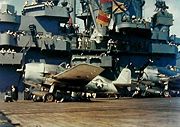

The Hellcat first saw action against the Japanese on 1 September 1943 when fighters off the USS Independence (CVL-22) shot down a Kawanishi H8K "Emily" flying boat.[17] Soon after, on 23 and 24 November, Hellcats engaged Japanese aircraft over Tarawa, shooting down a claimed 30 Mitsubishi Zeros for the loss of one F6F.[17] Over Rabaul, New Britain, on 11 November 1943, Hellcats and Corsairs were engaged in day-long fights with many Japanese aircraft including A6M Zeros, shooting down nearly 50 aircraft.[17] Hellcats also utilized the "Thach Weave", which had been developed into a formation tactic to compensate for the older F4F Wildcat's deficiencies.
Hellcats were involved in practically all engagements with Japanese air power from that point onward. It was the major U.S. Navy fighter type involved in the Battle of the Philippine Sea, where so many Japanese aircraft were shot down that Navy aircrews nicknamed the battle The Great Marianas Turkey Shoot. The F6F accounted for 75% of all aerial victories recorded by the U.S. Navy in the Pacific.[18] Radar-equipped Hellcat night fighter squadrons appeared in early 1944.
Navy and Marine F6Fs flew 66,530 combat sorties (45% of all fighter sorties of the war, 62,386 sorties were flown from aircraft carriers[19]) and destroyed 5,163 (56% of all Naval/Marine air victories of the war) at a cost of 270 Hellcats (an overall kill-to-loss ratio of 19:1).[20] The aircraft performed well against the best Japanese opponents with a 13:1 kill ratio against Mitsubishi A6M, 9.5:1 against Nakajima Ki-84, and 3.7:1 against Mitsubishi J2M during the last year of the war.[21] The F6F became the prime ace-maker aircraft in the American inventory, with 306 Hellcat aces.[22] That being said, it must be noted that the U.S. successes were not only attributed to superior aircraft, but also because they faced increasingly inexperienced Japanese aviators from 1942 onwards, as well as having the advantage of ever-increasing numerical superiority.
In the ground attack role, Hellcats dropped 6,503 tons of bombs.[20]
The British Fleet Air Arm received 1,263 F6Fs under the Lend-Lease Act and dubbed it Gannet I. The name Hellcat was eventually retained in early 1943 for the sake of simplicity, as the Royal Navy at that time adopted the use of the existing American naval names for all the U.S.-made aircraft supplied to it, with the F6F-3 being designated Hellcat F I, the F6F-5, the Hellcat F II and the F6F-5N, the Hellcat NF II. They saw action off Norway, in the Mediterranean and in the Far East. A number were fitted with photographic reconnaissance equipment similar to the F6F-5P, receiving the designation Hellcat FR II.[23] The FAA Hellcat units experienced far fewer opportunities for air-to-air combat than their USN/Marines counterparts; a total of 52 enemy aircraft were shot down during 18 aerial combats from May 1944 to July 1945. 1844 Squadron FAA, on board HMS Indomitable of the British Pacific Fleet was the highest scoring unit, with 32.5 kills.[24]
FAA Hellcats, as with other Lend-Lease aircraft, were rapidly replaced by British aircraft after the end of the war, with only two of the twelve squadrons equipped with the Hellcat at VJ-Day still retaining Hellcats by the end of 1945.[25] These two squadrons were disbanded in 1946.[25] In British service, the Hellcats proved to be a match even for the main Luftwaffe fighters, the Messerschmitt Bf 109 and Focke-Wulf Fw 190.
Postwar, the Hellcat was succeeded by the Grumman F8F Bearcat which was smaller than the Wildcat yet more powerful and more maneuverable than the Hellcat, but came online too late to see combat in World War II.[26] The Hellcat soldiered on in a number of second line USN duties including training. The French Aéronavale was equipped with F6F-5 Hellcats and used them in Indochina. The Uruguay Navy also used them until the early 1960s[27].
Operators
- French Navy
- Uruguayan Navy
Survivors
A relatively large number of Grumman F6Fs are survivors, either in museums or in flyable condition. In order of Bu.No. they are:[28]
- 041476 at Quantico MCAS, Virginia (the former US Marine Corps Museum).
- 041834 a F6F-3K in the markings of VF-5 during its USS Yorktown tour at the Smithsonian National Air and Space Museum, Washington D.C..
- 041930 at the Cinema Air Museum, Carlsbad, California. Formerly privately owned as N103V
- 042874 at the San Diego Air & Space Museum.
- 043014 at the Fantasy of Flight - Weeks Air Museum, Miami, Florida.
- 066237 at the National Museum of Naval Aviation, Pensacola, Florida.
- 070185 at the Quonset Air Museum, Rhode Island.
- 070222 with the Commemorative Air Force (formerly Confederate Air Force).
- 077122/077722 at Andrews Air Force Base.
- 078645 at the Yanks Air Museum, Chino, California.
- 079192 at the New England Air Museum, Connecticut (formerly the Bradley Air Museum).
- 079302/KE209 at the Fleet Air Arm Museum, Yeovil, Somerset, UK.
- 079593 in the colors of Cdr. James H. Flatley at the Patriot's Point Naval & Maritime Museum, Patriot's Point, Mount Pleasant, South Carolina.
- 079683 at the Kalamazoo Air Zoo Museum, Portage, Michigan. Formerly privately owned as N7968C.
- 079863 at Flying A Services, North Weald Airfield, UK. Formerly as N79863 with Aerial Classics at Atlanta, Georgia[29].
- 080141 in the colors of the VF-6 Hellcat of Alexander Vraciu at Imperial War Museum Duxford, UK. Formerly privately owned as N80142.
- 080166 at one time flew with the Commemorative Air Force, Midland, Texas as N1078Z. It crashed at one time.
- 093879 at the Planes of Fame Museum, Chino, California. Registered as N4994V it is one of the several still flyable Hellcats.
- 094203 in the colors of David McCampbells Minsi III at the National Museum of Naval Aviation, Pensacola, Florida. Registered as N7865C at one time. Photo to be found in Barrett Tillman's Hellcat- The F6F in World War II, p. 235.
- 094204 at the Lone Star Flight Museum, Galveston, Texas. Once privately owned as N4998V.
- 094263 at the Cradle of Aviation Museum, Garden City, New York (formerly at the US Marine Corps Museum).
- 094385 at the Museum of American Aircraft, Hayward, California.
- 094473/001006 at the Palm Springs Air Museum.
- 024895 at the USS Intrepid, New York finally is just a replica, not a real aircraft.
Specifications (F6F-5 Hellcat)

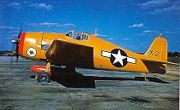
Data from Quest for Performance[30], Jane’s Fighting Aircraft of World War II[31], and Standard Aircraft Characteristics[32]
General characteristics
- Crew: 1
- Length: 33 ft 7 in (10.24 m)
- Wingspan: 42 ft 10 in (13.06 m)
- Height: 13 ft 1 in (3.99 m)
- Wing area: 334 ft² (31 m²)
- Airfoil: NACA 23015.6 mod root; NACA 23009 tip
- Empty weight: 9,238 lb (4,190 kg)
- Loaded weight: 12,598 lb (5,714 kg)
- Max takeoff weight: 15,415 lb (6,990 kg)
- Powerplant: 1× Pratt & Whitney R-2800-10W "Double Wasp" two-row radial engine with a two-speed two-stage supercharger, 2,000 hp (1,491 kW [33])
- Propellers: 3-blade Hamilton Standard
- Propeller diameter: 13 ft 1 in (4.0 m)
- * Fuel capacity: 250 U.S. gal (946 L) internal; up to 3x 150 U.S. gal (568 L) external drop tanks
- Zero-lift drag coefficient: 0.0211
- Drag area: 7.05 ft² (0.65 m²)
- Aspect ratio: 5.5
Performance
- Maximum speed: 330 knots (380 mph, 610 km/h)
- Stall speed: 73 knots (84 mph, 135 km/h)
- Combat radius: 820 nm (945 mi, 1,520 km)
- Ferry range: 1,330 nm (1,530 mi, 2,460 km)
- Service ceiling 37,300 ft (11,370 m)
- Rate of climb: 3,500 ft/min (17.8 m/s)
- Wing loading: 37.7 lb/ft² (184 kg/m²)
- Power/mass: 0.16 hp/lb (260 W/kg)
- Time-to-altitude: 7.7 min to 20,000 ft (6,100 m)
- Lift-to-drag ratio: 12.2
- Takeoff roll: 799 ft (244 m)
Armament
- Guns:
- either 6× 0.50 in (12.7 mm) M2 Browning machine guns, with 400 rounds/gun, (All F6F-3, and most F6F-5)
- or 2× 20 mm cannon, with 225 rounds/gun
- and 4× 0.50 in (12.7 mm) Browning machine guns with 400 rounds/gun (F6F-5N only)
- Rockets:
- 6 × 5 in (127 mm) HVARs or
- 2 × 11¾ in (298 mm) Tiny Tim unguided rockets
- Bombs: up to 4,000 lb (1,800 kg) full load, including:
- Bombs or Torpedoes:(Fuselage mounted on centreline rack)
- 1 × 2,000 lb (910 kg) bomb or
- 1 × Mk.13-3 torpedo;
- Underwing bombs: (F6F-5 had two additional weapons racks either side of fuselage on wing centre-section)
- 1 × 1,000 lb (450 kg) or
- 2 × 250 lb (110 kg)
- 6 × 100 lb (45 kg)
- Bombs or Torpedoes:(Fuselage mounted on centreline rack)
See also
- David McCampbell, a 34 victory Hellcat ace, commander of Air Group 15 during World War II and winner of the Medal of Honor.
- Eugene A. Valencia, Jr., top scoring ace of VF-9 during World War II with 23 victories while flying Hellcats.
- Alexander Vraciu, who had 19 victories on Hellcats flying with VF-6 (9) and VF-16 (10) during World War II.
Related development
- F4F Wildcat
- F8F Bearcat
Comparable aircraft
- F4U Corsair
- Mitsubishi A7M
Related lists
- List of aircraft of the Fleet Air Arm
- List of fighter aircraft
- List of military aircraft of the United States
References
Notes
- ↑ 1.0 1.1 1.2 Sullivan 1979, p. 4.
- ↑ Tillman 1996, p.81. Tillman gives a figure of 5,271.
- ↑ Tillman 1996, pp.78-79.
- ↑ U.S. Naval Aircraft Marking from US Naval Historical Center, retrieved 11/03/2008
- ↑ 5.0 5.1 Kinzey 1987, p. 6.
- ↑ Kinzey 1987, p. 58.
- ↑ Green 1975, p. 91.
- ↑ Green 1975, pp. 93–94.
- ↑ 9.0 9.1 9.2 Taylor 1969, p. 503.
- ↑ Kinzey 1987, p. 14.
- ↑ 5 inch FFAR/HVARRetrieved: 3 April 2008
- ↑ Sullivan 1979, pp. 24, 30, 33.
- ↑ F6F-5 test report (pdf file) Retrieved: 3 April 2008
- ↑ Kinzey 1987, p. 27.
- ↑ Sullivan 1979, p. 46.
- ↑ Winchester 2004, p. 110.
- ↑ 17.0 17.1 17.2 Dean 1997, p. 559.
- ↑ Tillman 1979, p. 9.
- ↑ Barber 1946, Table 1
- ↑ 20.0 20.1 Barber 1946, Table 2
- ↑ Barber 1946, Table 28.
- ↑ Airpower Classics Airforce Magazine, April 2006, p. 98.
- ↑ Green 1975, p. 93.
- ↑ Tillman 1996, p. 78.
- ↑ O'Leary 1980, pp. 147–48.
- ↑ Donald, David, ed. American Warplanes of World War II. London: Aerospace Publishing, 1995. ISBN 1-874023-72-7.
- ↑ Krist 2006, pp. 91–92.
- ↑ Tillman 1979, p. 237.
- ↑ Loftin, L.K. Jr. Quest for Performance: The Evolution of Modern Aircraft. NASA SP-468. Retrieved: 22 April 2006.
- ↑ Bridgman 1946, pp. 233–234.
- ↑ Standard Aircraft Characteristics: F6F-5 Hellcat. NAVAER 1335A.
- ↑ Mondey 2006, p. 145.
Bibliography
- Anderton, David A. Hellcat. London/Sydney: Jane's Publishing Company Ltd., 1981. ISBN 0-7106-0036-4.
- Barber, S.B. Naval Aviation Combat Statistics: World War II, OPNAV-P-23V No. A129. Washington, DC: Air Branch, Office of Naval Intelligence, 1946.
- Bridgman, Leonard, ed. “The Grumman Hellcat.” Jane’s Fighting Aircraft of World War II. London: Studio, 1946. ISBN 1-85170-493-0.
- Brown, Eric, CBE, DCS, AFC, RN., William Green and Gordon Swanborough. "Grumman Hellcat". Wings of the Navy, Flying Allied Carrier Aircraft of World War Two. London: Jane's Publishing Company, 1980, pp. 167–176. ISBN 0-7106-0002-X.
- Dann, Lcdr. Richard S. USNR. F6F Hellcat Walk Around. Carrollton, Texas: Squadron/Signal Publications Inc., 1996. ISBN 0-89747-362-0.
- Dean, Francis H. America's Hundred Thousand. Atglen, PA: Schiffer Publishing Ltd., 1997. ISBN 0-7643-0072-5.
- Drendel, Lou. "Grumman F6F Hellcat". U.S. Navy Carrier Fighters of World War II. Carrollton, TX: Squadron/Signal Publications Inc., 1987, pp. 45–68. ISBN 0-89747-194-6.
- Green, William. Famous Fighters of the Second World War. Garden City, NY: Doubleday & Company, 1975. ISBN 0-385-12395-7.
- Green, William and Gordon Swanborough. "Grumman F6F Hellcat". WW2 Fact Files: US Navy and Marine Corps Fighters. London: Macdonald and Jane's Publishers Ltd., 1976, pp. 47–56. ISBN 0-356-08222-9.
- Hill, Richard M. Grumman F6F-3/5 Hellcat in USN-USMC-FAA-Aeronavale & Uruguayan Service. Reading, Berkshire, UK: Osprey Publications Ltd., 1971. ISBN 1-85045-023-3.
- Jarski, Adam and Waldemar Pajdosz. F6F Hellcat (Monografie Lotnicze 15) (in Polish). Gdańsk, Poland: AJ-Press, 1994. ISBN 83-86208-05-8.
- Jarski, Adam and Waldemar Pajdosz. F6F Hellcat (Aircraft Monograph 20). Gdańsk, Poland: AJ-Press, 2007.
- Kinzey, Bert. F6F Hellcat in detail and scale (D&S Vol.26). Shrewsbury, UK: AirLife Publishing Ltd., 1987. ISBN 1-85310-603-8.
- Kinzey, Bert. F6F Hellcat in detail and scale (D&S Vol.49). Carrollton, Texas: Squadron/Signal Publications Inc., 1996. ISBN 1-888974-00-1.
- Kit, Mister and Jean-Pierre De Cock. F6F Hellcat (in French). Paris, France: Éditions Atlas s.a., 1981.
- Krist, Jan. Bojové Legendy: Grumman F6F Hellcat (in Czech). Prague, Czech Republic: Jan Vašut s.r.o., 2006. ISBN 80-7236-432-9.
- Mendenhall, Charles A. Wildcats & Hellcats: Gallant Grummans in World War II. Osceola, WI: Motorbooks International, 1984. ISBN 0-87938-177-9.
- Mondey, David. American Aircraft of World War II (Hamlyn Concise Guide). London: Bounty Books, 2006. ISBN 978-0-7537-1461-4.
- O'Leary, Michael. United States Naval Fighters of World War II in Action. Poole, Dorset, UK: Blandford Press, 1980. ISBN 0-7137-0956-1.
- Sullivan, Jim. F6F Hellcat in action. Carrollton, Texas: Squadron/Signal Publications Inc., 1979. ISBN 0-89747-088-5.
- Taylor, John W.R. "Grumman F6F Hellcat." Combat Aircraft of the World from 1909 to the present. New York: G.P. Putnam's Sons, 1969. ISBN 0-425-03633-2.
- Thetford, Owen. British Naval Aircraft Since 1912, Fourth Edition. London: Putnam, 1994. ISBN 0-85177-861-5.
- Thomas, Geoff. US Navy Carrier Aircraft Colours: Units, Colours, Markings, and Operations during World War 2. New Malden, UK; Air Research Publications, 1989. ISBN 1-871187-03-6.
- Tillman, Barrett. Hellcat: the F6F in World War II. Annapolis, MD: Naval Institute Press, 1979. ISBN 0-87021-265-6.
- Tillman, Barrett. Hellcat Aces of World War 2. London: Osprey Aerospace, 1996. ISBN 1-85532-596-9.
- Winchester, Jim, ed. "Grumman F6F Hellcat." Aircraft of World War II. Rochester, UK: Grange Books plc, 2004. ISBN 1-84013-639-1.
- Zbiegniewski, Andre R. Grumman F6F Hellcat (Kagero Monografie No.10) (Bilingual Polish/English). Lublin, Poland: Kagero, 2004. ISBN 83-89088-49-5.
External links
- WW2DB: F6F Hellcat
- How Leroy Grumman and Jake Swirbul built a high-flying company from the ground up
- Final flight test report of F6F-3, USN Air Station, Patuxent River (pdf file)
- F6F Hellcat Performance Trials, Aircraft and Armament Experimental Establishment (A&AEE), Boscombe Down
- Performance test, each 1,00th aircraft; F6F-5 No 58310, USN Air Station, Patuxent River (pdf file).
- USN & USMC Aircraft Serial and Bureau No.s 1911 to present
|
||||||||
|
|||||
|
||||||||||||||
